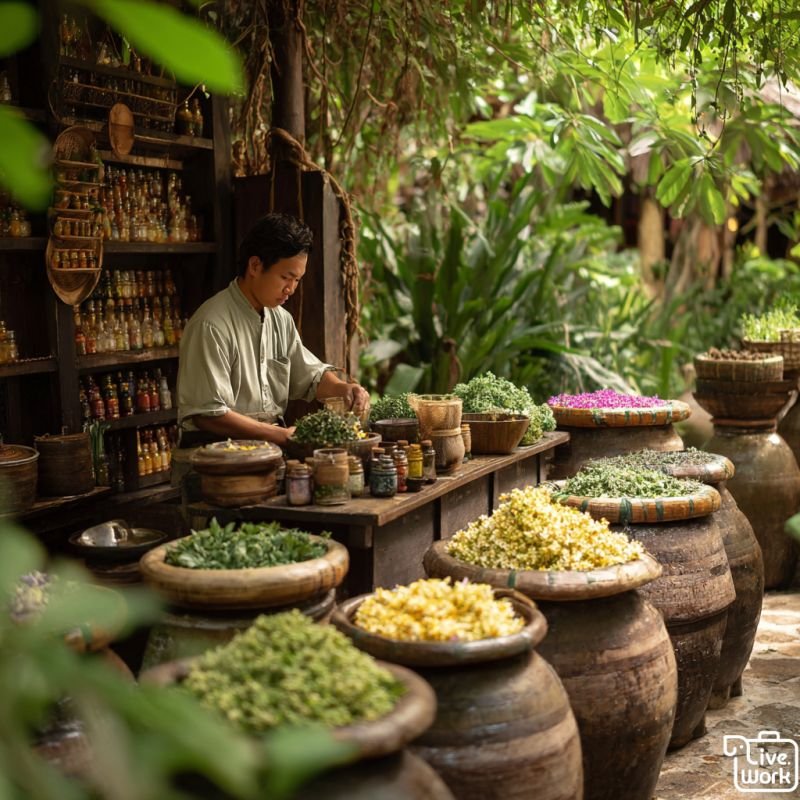Thai Aromatherapy: A Sensory Journey into Tradition and Wellness
In Thailand, wellness is not just a lifestyle—it is a cultural legacy woven into daily life. One of the most profound expressions of this legacy is Thai aromatherapy, an ancient practice that harmonizes body and spirit through the power of scent. Rooted in holistic healing and Buddhist philosophy, Thai aromatherapy bridges centuries-old traditions with the global demand for natural and sustainable wellness practices. Whether you are seeking emotional balance, physical healing, or simply a deeper connection to Thai culture, aromatherapy offers a richly immersive path.
🧘♀️ The Origins of Thai Aromatherapy
Thai aromatherapy traces its lineage back to a confluence of influences—Ayurvedic medicine from India, traditional Chinese medicine, and indigenous Thai herbalism. These systems merged over centuries, culminating in a uniquely Thai approach that values the balance of the body’s elements: earth, water, wind, and fire.
Temples, traditional healers (known as mo boran), and Thai massage therapists have long used essential oils and aromatic herbs not just to heal the body but to calm the mind and restore spiritual harmony. The practice is closely tied to Buddhist rituals, where incense and fragrant oils are used in meditation and temple offerings to create sacred spaces.
🌿 Signature Scents of Thailand
Thai aromatherapy is characterized by its use of native botanicals, each carrying unique healing properties and deep cultural symbolism:
🌼 Jasmine (Dok Mali)
Symbol of purity and maternal love in Thai culture.
Calms the nervous system, relieves anxiety, and enhances emotional well-being.
Commonly used in spiritual offerings and royal rituals.
🍋 Lemongrass (Takrai)
Pungent and citrusy, it’s a staple in both Thai cuisine and wellness.
Possesses anti-inflammatory, antifungal, and mood-boosting properties.
Often used in massage oils to relieve muscle tension and improve circulation.
🌲 Sandalwood (Mai Chan Hom)
Earthy and grounding, sandalwood is revered for its meditative qualities.
Used in traditional temple incense to aid concentration and spiritual clarity.
🍃 Kaffir Lime (Makrut)
The invigorating scent of kaffir lime is believed to clear negative energy.
Often found in herbal compresses and steam treatments.
🌸 Plai (Zingiber Cassumunar)
A relative of ginger, plai has warming and analgesic properties.
Used in balms and massage treatments to ease muscle and joint pain.
💆♀️ Thai Aromatherapy in Practice
Thai aromatherapy is more than diffusers and essential oils—it is a multi-sensory experience that incorporates various healing modalities:
🛁 Herbal Steam Rooms and Compresses
Herbal steam rooms infused with lemongrass, turmeric, and kaffir lime are popular in both spas and traditional villages. Herbal compresses (luk pra kob), heated and pressed on the body, combine aromatherapy with acupressure to relieve pain and improve energy flow.
💨 Inhalers and Balms
Pocket-sized inhalers made from camphor, eucalyptus, and menthol are ubiquitous in Thailand, offering instant relief from congestion, dizziness, or stress. Aromatic balms, like the famous green balm (ya mong), are used to soothe headaches and muscle soreness.
🕯️ Aromatherapy Massages
Luxury Thai spas blend essential oils into massage oils, tailoring the experience to the client’s needs—invigorating blends for energy, calming oils for sleep, or grounding scents for mental clarity.
🧴 Aromatherapy and Thai Spa Culture
Thailand’s wellness tourism industry is globally renowned, with Thai spas offering world-class aromatherapy treatments that integrate seamlessly with Thai massage, meditation, and herbal therapies. Resorts in Chiang Mai, Phuket, and Koh Samui often include personalized aromatherapy consultations, making this tradition accessible to global visitors.
The Five-Star Spa Experience often includes:
Welcome rituals with floral-scented towels
Foot baths in lemongrass-infused water
Oil-based massage therapy with local aromatic blends
Herbal teas served post-treatment to enhance detoxification
🌏 Thai Aromatherapy in a Global Context
With the rise in interest for holistic and sustainable wellness, Thai aromatherapy is gaining traction globally. Thai essential oils and herbal preparations are now exported worldwide, and many international spas have adopted Thai techniques and ingredients into their offerings.
But what sets Thai aromatherapy apart is its deep connection to community, tradition, and nature. Many Thai products are produced in rural villages by artisan cooperatives, ensuring that ancient knowledge is preserved and passed on through generations.
🌱 Sustainable and Ethical Wellness
Modern Thai aromatherapy also aligns with eco-conscious values:
Wildcrafted or organic herbs are often used.
Packaging is increasingly sustainable.
Proceeds from spa and wellness centers often support local artisans and small-scale farmers.
By supporting Thai aromatherapy products and treatments, consumers contribute to both environmental sustainability and cultural preservation.
🙏 Final Thoughts: A Journey Beyond the Senses
Thai aromatherapy is more than indulgence—it is a ritual of connection, to oneself, to nature, and to centuries of wisdom. Whether experienced in a luxury spa or through a homemade balm, its effects are tangible and lasting.
So next time you inhale the calming scent of jasmine or the energizing spark of lemongrass, remember: you are partaking in a living tradition, a sensory story that has traveled through time from the heart of Thailand to you.
